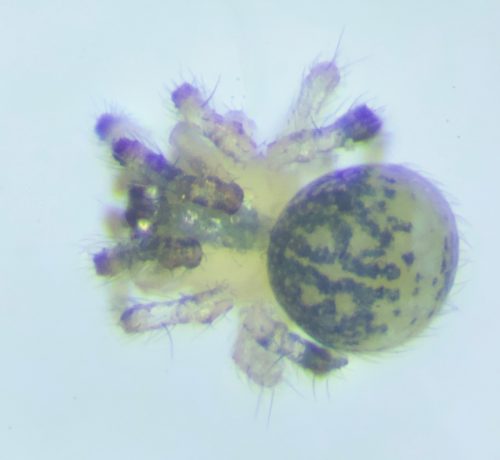I’ve been eagerly checking on my colony every day for the last week or two, because I was expecting a happy event. Tonight, it happened! The babies hatched out!
I expect you all to follow the the tradition and tell me how beautiful my baby is.
Well? I’m waiting!
There were somewhere upward of 80 babies that emerged today. This meant I had to immediately separate all of them into individual vials, or in many cases, 2 or 3 babies in a vial (I’ll separate them further later). I was just sitting there frantically plucking up spiders with a paintbrush and popping them into new vials, which was busy enough, but then…oops. I dropped the egg sac. I’m a klutz.
What happened next is that swarms of tiny, pin-head sized spiders were scurrying off to escape, usually taking flight on a thread of silk. So for about 20 minutes I was sitting there with a paintbrush in one hand and watchmaker forceps in the other, squinting into the air of the lab, my hands darting out to snag a nearly invisible strand of gossamer silk with a nearly microscopic dot of a baby spider on it.
I know some of them got away (sorry, lab neighbors — they’re tiny and cute, don’t worry) because even as I was putting everything away to go home I kept finding more strands hanging from my microscope, or from my computer, or from me. Who knows? I might have some on me right now.
I’ve got lots of baby spiders stuffed into my incubator now. Tomorrow I’ll give each one a fly, and I’ll start tracking their development and health.
Note the “R”. I’m calling this my Runestone line, because the mother (in the individual vial) and the egg sac were collected at Kensington Runestone park.
Now for a little dread: I’ve got 6 more egg sacs in the lab. I’m gonna need a bigger incubator and more tube racks.




Aw…look at the fuzzy-wuzzy leggy-weggies. It’s so cute. :)
Mad scientist lets spiders escape from lab. I’ve seen that movie.
Yes, beautiful (how can everyone not see that?). I’m always surprised by the number of baby spiders that emerge from the egg cases of orb spiders. There must be a very heavy predation on them.
Congrats! How’s it feel to be a proud Poppa again?
BTW, I’m a little forgetful of the protocol. Is it one cigar per baby?
Awwww, what beautiful babies!
From what I’ve seen most of your work is currently focused on charting the largely unknown and definitely not-yet-formalised waters of spider husbandry. I am curious as to what you intend to accomplish with them scientifically once that routine is settled. I assume it will be functionally comparable to the evolutionary development work you did with the zebra fish, but even there I don’t know what sort of specific research you were engaged in.
Do they really eat eachother, or is that baby mantids?
Either way, it’s a good tshirt: “I like to watch my kids consume eachother and fight to survive,”
Aw, how cute! They are absolutely adorable when they’re that tiny. ( I had some in my bathroom about a week ago. My husband couldn’t stand it. I thought they were cute.)
More adorable than most babies, certainly (human ones look like avocados! (the dark wrinkly kind, not (usually, at least) the smooth green kind, as I commented to the midwife at the time).
Your mishap with the egg sac reminds me of the tale my mum once told me, when manymany years ago a visiting scientist accidentally knocked a container and released an entire contingent of crickets … they say that if you’re working alone in the lab late at night, when all is quiet, you can still hear the chirping of their descendents even now; playing their güiros with impunity as they travel happily around their domain via the ventilation ducts, where nobody can get at them.
Just don’t tell your colleagues it was you, so they won’t know who to blame in days to come when the spiderlings take over.
My last experiment/observation with zebrafish was a student’s excellent work in studying the migration of neural crest derivatives in the formation of zebrafish stripes.
Right now I’m focused on getting the basics of spider taxonomy and breeding down. I have a student who might be able to work in the lab in the fall, virus permitting, who will be doing a comparison of web- and nest-building in two closely related species of Parasteatoda — that’s going to be largely a behavioral study. Long-term, I’ll be looking at the heritability of behavioral traits — lots of people have been studying this in spiders, because they have distinctive variations in individual personality.
Add the genetics of web making to other behaviours and the complexity will be enormous and complex I think. Will you extend to looking at differences in genetics between orb weavers, wolf spiders, jumping spiders, trapdoor. spiders and so on?
No. I’m focusing on cobweb spiders, Theridiidae. The plan is to stick with two closely related species with one difference in their web-building behavior. I’m working with undergrads, so short projects with strongly limited goals that they can get done in a year.
Sorry PZ, got a bit carried away there…